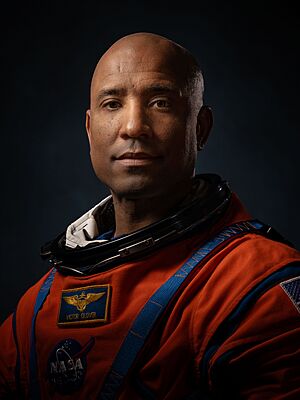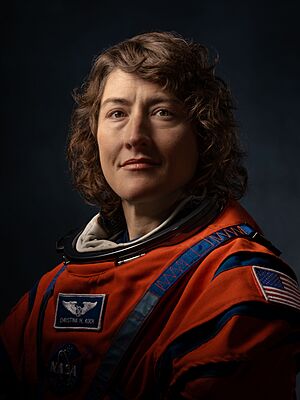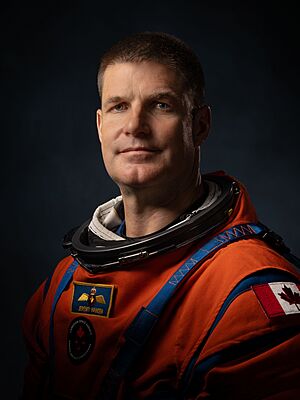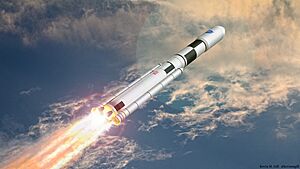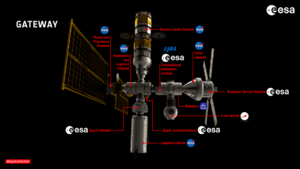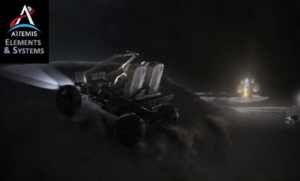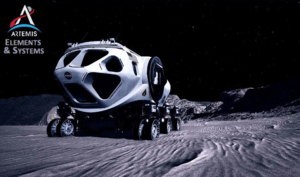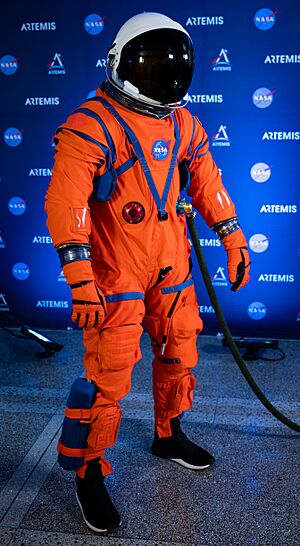Artemis program facts for kids
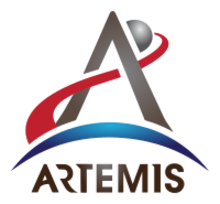 |
|
| Country | United States |
|---|---|
| Organization | NASA and partners: ESA, JAXA, DLR, UKSA, ASI, ISA, MBRSC, and CSA |
| Purpose | Sustainable crewed lunar exploration |
| Status | Ongoing |
| Program history | |
| Cost | US$93+ billion (2012–2025), $53 billion in 2021–2025 |
| Duration | 2017–present |
| First flight | Artemis I (November 16, 2022, 06:47:44 UTC) |
| First crewed flight | Artemis II (NET February 2026) |
| Launch site(s) | |
| Vehicle information | |
| Crewed vehicle(s) |
|
| Crew capacity | 4 |
| Launch vehicle(s) |
|
The Artemis program is a big space project led by NASA in the United States. Its main goal is to send humans back to the Moon for the first time since 1972. The program also aims to build a permanent base on the Moon. This base would help prepare for future human missions to Mars.
Artemis uses some parts from older space programs, like the Orion spacecraft and parts of the Space Launch System (SLS) rocket. New parts are also being built, such as the Lunar Gateway space station and the Human Landing System (HLS). Many different space agencies and private companies from around the world are working together on Artemis.
The main parts of the Artemis program are the SLS rocket, the Orion spacecraft, and the Human Landing System. The Lunar Gateway space station will help support astronauts. Other important parts include robotic landers, Moon rovers, and special spacesuits.
The first mission, Artemis I, launched on November 16, 2022. It was an uncrewed test flight with robots and mannequins. The next mission, Artemis II, is planned to carry astronauts around the Moon in early 2026. After that, Artemis III is scheduled for mid-2027, aiming to land humans on the Moon. NASA plans to have yearly Moon landings after Artemis VI.
Contents
What is the Artemis Program?
The Artemis program is a series of missions using the Space Launch System (SLS) rocket. Each mission will become more complex over time. NASA and its partners have planned missions from Artemis I through Artemis V. Later missions are also being discussed. Every SLS mission involves launching an SLS rocket with an Orion spacecraft on top. Missions after Artemis II will also need support from other rockets and spacecraft.
Artemis I: The First Test Flight
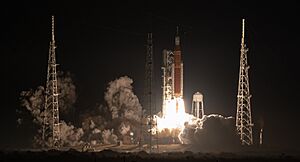
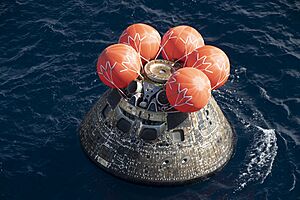
Artemis I launched on November 16, 2022. It was a successful test flight without a crew for both the SLS rocket and the Orion spacecraft. The Orion capsule traveled around the Moon and then returned safely to Earth. It splashed down in the Pacific Ocean on December 11, 2022. This was 50 years to the day after the last human Moon landing, Apollo 17.
Artemis II: First Crewed Flight Around the Moon
Artemis II is planned to be the first mission with a crew using the SLS and Orion. Four astronauts will fly around the Moon and return to Earth. The launch is scheduled for early 2026.
The crew for Artemis II includes:
- Commander Reid Wiseman (USA)
- Pilot Victor J. Glover (USA)
- Payload Specialist Christina Koch (USA)
- Mission Specialist Jeremy Hansen (Canada)
Victor Glover will be the first person of color to travel beyond Earth orbit. Christina Koch will be the first woman, and Jeremy Hansen will be the first non-US citizen to do so.
Artemis III: Landing Humans on the Moon Again
Artemis III is planned for mid-2027. This mission aims to be the first time Americans land on the Moon since 1972. Before the crew launches, a Starship Human Landing System (HLS) will be sent to orbit the Moon. The Orion spacecraft will then carry four astronauts to dock with the HLS. Two astronauts will transfer to the HLS and land on the Moon for about 6.5 days. They will do at least two spacewalks on the surface. After their work, the HLS will take them back to Orion, and all four astronauts will return to Earth.
Science on Artemis III
NASA has chosen three science tools for Artemis III:
- Lunar Environment Monitoring Station (LEMS): This will measure moonquakes to help scientists understand the Moon's inside.
- Lunar Effects on Agricultural Flora (LEAF): This will study how the Moon's environment affects plants grown in space.
- Lunar Dielectric Analyzer (LDA): This tool will measure how well the Moon's soil can carry an electric field.
Artemis IV: Expanding the Lunar Gateway
Artemis IV is planned for September 2028. This will be the second crewed Moon landing mission. Before this, the first two parts of the Lunar Gateway station will be sent to lunar orbit. The Artemis IV mission will then bring the International Habitation Module (I-Hab) to connect with the Gateway. This mission will use a more powerful version of the SLS rocket.
Artemis V: New Lander and Rover
Artemis V is planned for March 2030. This mission will take four astronauts to the Lunar Gateway. It will also deliver two new parts to the Gateway: the ESPRIT refueling module and the Canadarm3 robotic arm. This mission will be the first to use Blue Origin's Blue Moon lander to take astronauts to the Moon's surface. It will also deliver NASA's Lunar Terrain Vehicle (LTV), which is a rover for astronauts to drive on the Moon.
Artemis VI: Adding an Airlock to Gateway
Artemis VI is planned for March 2031. This mission will add the Crew and Science Airlock Module to the Lunar Gateway space station. It will also include another crewed landing on the Moon.
Future Artemis Missions
- Artemis VII (March 2032): This mission will deliver the Lunar Cruiser (a special rover) to the Moon's surface.
- Artemis VIII (2033): This mission will land astronauts and deliver supplies and a Foundational Surface Habitat (a first Moon home).
- Artemis IX (2034): This mission will deliver more supplies and be the first to use an even more powerful SLS Block 2 rocket.
- Artemis X (2035): This mission will deliver more supplies and include astronauts staying on the Moon for a longer time, up to 180 days.
For many Artemis missions, parts of the rockets and spacecraft, like engines and boosters, are reused from the old Space Shuttle program. This helps save money and resources.
Supporting Missions
Many other missions are needed to help the Artemis program succeed. These include robotic landers, missions to deliver parts for the Gateway, and missions to bring supplies to the Moon base. Most of these are done by private companies working with NASA.
Commercial Lunar Payload Services (CLPS)
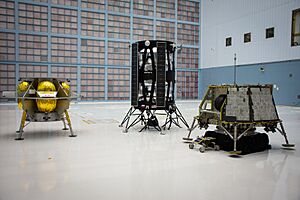
The Commercial Lunar Payload Services (CLPS) program sends small robotic landers and rovers to the Moon. These missions help explore the Moon's south pole, look for resources like water ice, and test new technologies. Many different companies are involved in CLPS.
Human Landing System (HLS)
The Human Landing System (HLS) is a spacecraft that carries astronauts from lunar orbit to the Moon's surface and back. Each crewed landing needs an HLS. SpaceX's Starship HLS was chosen by NASA for the first crewed lunar landing. Later, Blue Origin was also chosen to develop another lunar lander.
Lunar Gateway Modules
The first two parts of the Lunar Gateway space station, the PPE and HALO modules, will be launched together by a Falcon Heavy rocket in 2027. The Gateway will be resupplied by Dragon XL spacecraft, which are launched by Falcon Heavy rockets. These Dragon XL spacecraft will stay attached to the Gateway for months and then be disposed of on the Moon.
History of Artemis
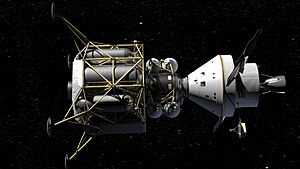
The Artemis program uses ideas and parts from earlier NASA programs that were cancelled, like the Constellation program. In 2010, President Obama cancelled parts of Constellation but called for a new heavy-lift rocket and continued work on the Orion spacecraft.
In 2017, President Donald Trump signed a new space policy that focused on returning humans to the Moon with private and international partners. This effort was later named Artemis. The name Artemis comes from Greek mythology; Artemis is the goddess of the Moon and twin sister of Apollo (the name of the first Moon landing program).
In 2019, Vice President Mike Pence announced that the Moon landing goal would be sped up to 2024. However, due to various challenges, the first crewed landing was later delayed to mid-2027.
Spacecraft and Vehicles
Orion Spacecraft
The Orion is a partially reusable spacecraft. It has a Crew Module built by Lockheed Martin and a service module built by Airbus. Orion can carry up to six astronauts beyond Earth orbit. It has solar panels for power and an automated docking system. Orion is mainly launched by the Space Launch System (SLS) rocket.
Human Landing System (HLS)
The HLS is a key part of the Artemis mission. It carries astronauts from lunar orbit to the Moon's surface, acts as a temporary home, and then takes them back to orbit.
Starship HLS
The Starship HLS is a special version of SpaceX's Starship spacecraft designed for the Moon. It doesn't have a heat shield because it won't re-enter Earth's atmosphere. The entire spacecraft lands on the Moon and then launches back from it. It uses special engines for landing and takeoff to avoid kicking up too much dust. Starship HLS needs to be refueled in Earth orbit by other Starship tanker spacecraft before it can travel to the Moon.
Blue Origin HLS
Blue Origin is developing a second crewed lunar lander called Blue Moon. It is smaller than Starship HLS and uses liquid hydrogen and oxygen as fuel. It is planned to make its first crewed flight on the Artemis V mission.
Lunar Gateway
The Lunar Gateway is a small space station that will orbit the Moon. It will act as a communication hub, a science lab, and a place for astronauts to stay for short periods. It will also be a holding area for rovers and other robots. NASA is leading the project, but it's a team effort with partners from Canada, Europe, and Japan.
The Gateway will have a Power and Propulsion Element (PPE) that provides power and helps move the station. The Habitation and Logistics Outpost (HALO) will be a small living area for astronauts. Europe and Japan will provide other modules, like a habitat module (I-HAB) and a refueling module (ESPRIT).
Astronauts for Artemis
NASA has a group of astronauts, including some from the Canadian Space Agency, who are training for the Artemis program. These astronauts could be part of the first crews to fly to the Moon and possibly to Mars in the future.
The crew for Artemis II has already been announced. All 42 active NASA astronauts and ten more in training are eligible for future Artemis flights.
Planned Moon Operations
NASA plans to build an Artemis Base Camp on the Moon's south pole. This area is chosen because it has a variety of lunar features and is believed to have water ice in its soil. The base camp will support missions lasting up to two months. It will help test technologies for future Moon or Mars bases.
The base camp will have three main parts:
- Surface Habitat (SH): This will be the first living structure for astronauts on the Moon.
- Lunar Terrain Vehicle (LTV): This is an unpressurized rover for astronauts to drive around the base.
- Pressurized Rovers (PR): These are larger, sealed vehicles that can carry astronauts for longer trips, even for multiple days away from the base.
Transportation on the Moon
Lunar Terrain Vehicle (LTV)
The Lunar Terrain Vehicle (LTV) is a rover that will be sent to the Moon before astronauts arrive. It will help transport crews and cargo around the landing site, similar to the rovers used in the Apollo missions. NASA wants the LTV to carry 800 kg of cargo, travel up to 20 km without recharging, and survive the lunar night.
Pressurized Rover (PR)
The Lunar Cruiser is a large, sealed rover that will allow astronauts to explore far from the base and live inside for several days. NASA is working with JAXA (Japan's space agency) and Toyota to develop this rover. It is planned to carry two astronauts for up to 30 days. Japanese astronauts will also get seats on future Moon missions as part of this partnership.
Spacesuits for Artemis
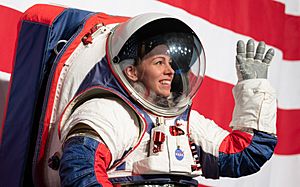
The Artemis program will use two types of spacesuits:
- Exploration Extravehicular Mobility Unit (xEMU): This suit is for spacewalks on the Moon's surface.
- Orion Crew Survival System (OCSS): This suit is worn by astronauts during launch and re-entry.
NASA has chosen private companies, Axiom Space and Collins Aerospace, to develop and produce these spacesuits.
Artemis Missions Overview
Here is a summary of the main Artemis missions:
| Mission | Patch | Launch date | Crew | Launch vehicle | Lander vehicle | Duration | Goal | Status |
|---|---|---|---|---|---|---|---|---|
| Artemis I | November 16, 2022 | N/A | SLS Block 1 | N/A | 25 days | Uncrewed lunar orbit and return | Success | |
| Artemis II | Early 2026 | SLS Block 1 | N/A | 10 days | 4-person lunar flyby | Planned | ||
| Artemis III | Mid-2027 | TBA | SLS Block 1 | Starship HLS | ~30 days | 4-person lunar orbit with 2-person lunar landing. | Planned | |
| Artemis IV | September 2028 | TBA | SLS Block 1B | Starship HLS | ~30 days | Delivery of the I-HAB module to the Lunar Gateway, followed by a 2-person lunar landing. | Planned | |
| Artemis V | March 2030 | TBA | SLS Block 1B | Blue Moon | ~30 days | Delivery of the ESPRIT module to the Lunar Gateway, followed by a 2-person lunar landing with the Lunar Terrain Vehicle. | Planned | |
| Artemis VI | March 2031 | TBA | SLS Block 1B | TBA | ~30 days | Delivery of the Crew and Science Airlock module to the Lunar Gateway, followed by a lunar landing. | Planned |
Images for kids
See also
 In Spanish: Programa Artemis para niños
In Spanish: Programa Artemis para niños
- Apollo program
- Chandrayaan programme - Indian Lunar Exploration Program
- Chinese Lunar Exploration Program – Chinese Moon program
- Colonization of the Moon
- List of Artemis Astronauts
- Commercial Crew Development
- Deep Space Transport
- International Lunar Research Station
- List of crewed spacecraft
- List of missions to the Moon
- NASA Astronaut Group 23
- Space policy of the United States
- Coordinated Lunar Time


